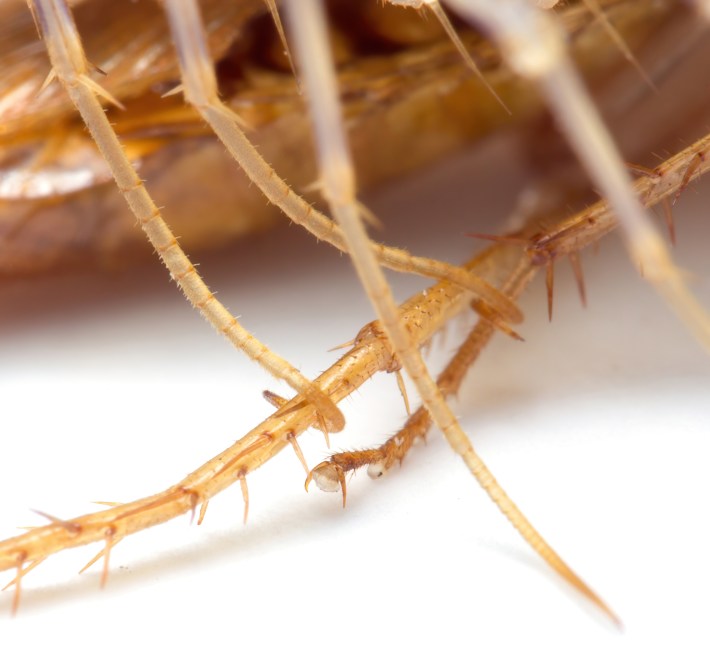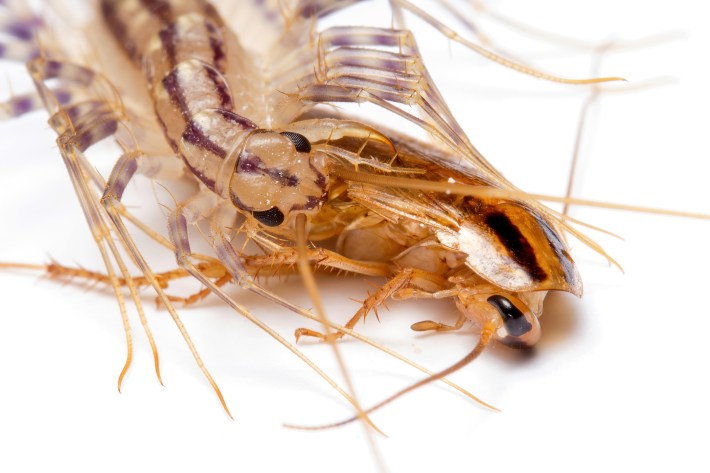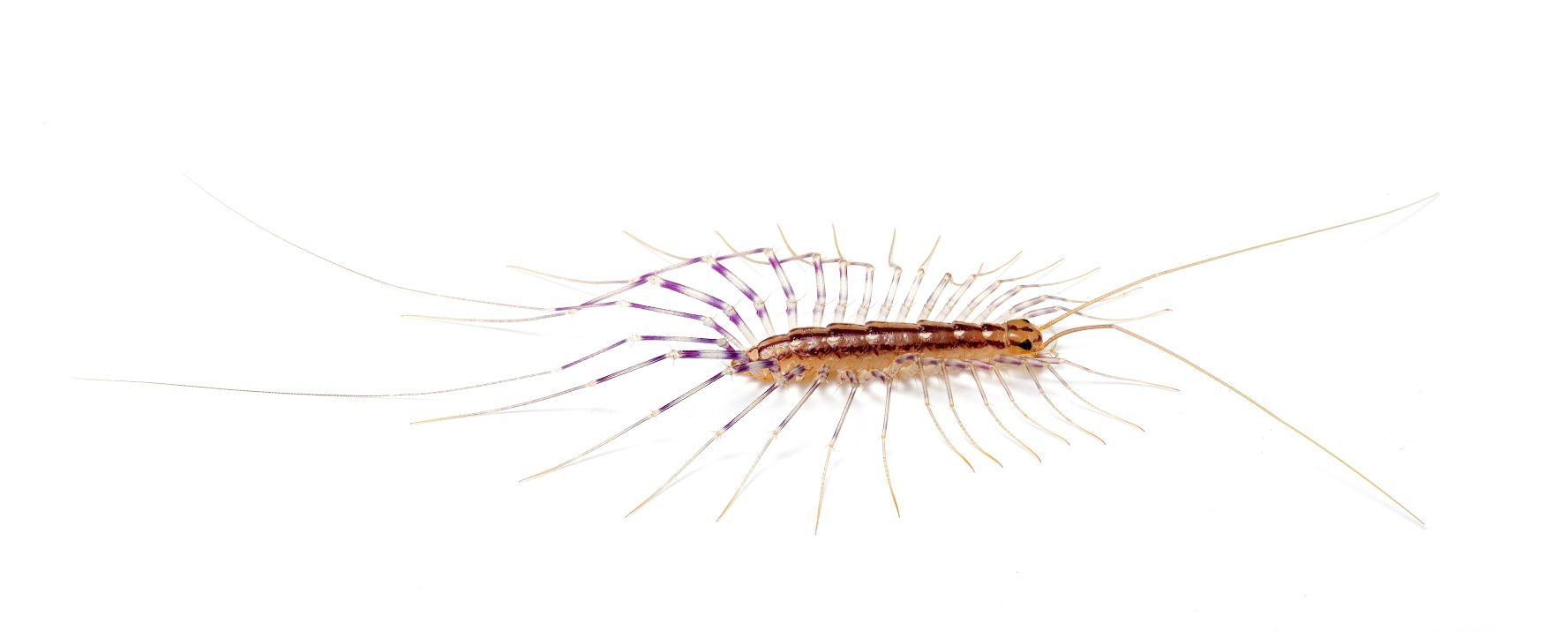Welcome to Meet Our Little Neighbors, an occasional series about the little guys who live among and around us, but rarely get the attention they deserve.
A few months ago, one of my roommates, who is a cat, ate another one of my roommates, who was a house centipede. The entire incident would have escaped my notice had I not seen Melon (the cat) hunched over with spindly legs protruding from her mouth like an extra set of whiskers. It was too late to save the house centipede (given name unknown), half-swallowed but still valiantly twitching, but, briefly, I mourned its death.
The first time I saw a house centipede skittering up on my ceiling while lying in bed, I knew that I hated it. I hated how its body looked like a conjoined pair of false eyelashes capable of uncanny speed—flitting across my wall faster than a foot per second. When it stood still, I hated that I couldn’t tell which end was its head and which end was its rear: Which way will you skitter next?! For years I killed house centipedes whenever the occasion presented itself, until I learned that they are tiny assassins who eat the other uninvited guests, such as bedbugs and cockroaches, who would harm me or eat my food. If I were a medieval monarch, the house centipede would be my tiniest champion, swiftly dispatching intruders in the still of the night.
It is impossible to live somewhere without bugs. They invariably glide, sneak, or bore their way into the sanctity of our homes to march and feed and swarm. And removing them is an unending battle, each bug prompting a flash decision in response to one of the greatest, most fraught questions of human existence: to smush, or not to smush? If I see a bug creeping in my kitchen near my food, I am often inclined to smush. In other rooms, I am far likelier to pardon said bug. Mosquitoes, however, I always smush on sight.
But I now have an open-door policy for house centipedes (which are not insects but arthropods, more closely related to lobsters than beetles). They are some of the best roommates I have ever had, perhaps because they are incapable of being passive-aggressive in a group chat or vomiting in the kitchen sink. So I feel it is my moral obligation to share what I have learned about the house centipede, to dilute any latent repulsion to its leggy body, and maybe even to spark in you some feeling of kinship with a creature that is probably your roommate too, if you live in the United States.
Who Is This Little Guy?
The house centipede Scutigera coleoptrata has 30 segmented legs, which seems to me a totally reasonable number of legs (despite what their name might suggest, no centipede has exactly 100 legs.) Baby house centipedes do not hatch with all 30 of these legs, but instead accumulate them as they molt into maturity. Unlike the legs of other centipedes, the last segment of each house centipede’s leg is prehensile, able to wrap around something and take hold. “Like a bendy straw,” said Matt Bertone, an entomologist who directs North Carolina State University's Plant Disease and Insect clinic.

But not all of these legs are made for walkin'. “Centipedes have found these ways to modify their legs for whatever they need,” said Derek Hennen, a research associate at the Virginia Museum of Natural History.
What appear to be long, spidery antennae protruding from the house centipede’s rear are actually a pair of modified legs that can grow twice as long as its body. These are, quite deservedly, called the centipede’s “ultimate legs.” Scientists suggest house centipedes use their ultimate legs as sensory appendages, held aloft and only touching the ground in a "probing" manner, according to a 2017 study published in the journal PeerJ.
Right under its head, the house centipede has a pair of fangs that, too, are highly modified legs. (If you liked Is It Cake?, you’ll love Is It Leg?) Called forcipules, these legs resemble pincers and make the centipede a powerful predator: able to seize prey and inject it with venom. So the centipede uses its locomotory legs to run up to prey, uses its forcipule legs to puncture and kill the prey, and their ultimate legs to sense anything that may be creeping up behind them. “They’ll eat whatever they can get their legs on,” Bertone said.
What’s Their Deal?
To a house centipede, the average suburban home is a veritable Sizzler buffet. In a 2016 study published in PeerJ, Bertone and colleagues surveyed the biodiversity of arthropods living in 50 houses in North Carolina and found each home had, on average, about 100 morphospecies, meaning species that can be distinguished just from their appearance. These included speck-sized housemates such as dust mites, as well as larger, more intrusive housemates such as drain-dwelling moth flies, spitting spiders, silverfish, and cockroaches—all of which are handily dispatched and swiftly devoured by the house centipede. “They’re like the cheetahs of the arthropod world,” Bertone said. “They run really fast and pounce on their prey.”
What Can This Little Guy Do to Me?
House centipedes often go unnoticed because they are nocturnal. But if you flick on your light and see one on a wall or ceiling, the house centipede will most likely run away from you. “They’re very timid,” Bertone said. “They’d rather get out of the situation than to risk getting killed.” They do not want to be perceived by humans, because we are big and threatening and often try to murder them gruesomely with a shoe.
House centipedes can certainly perceive us. Most centipedes have simple eyes called ocelli, which are capable of detecting light from dark. But centipedes in the order Scutigeromorpha, which contains house centipedes, have compound eyes: faceted black gems that look like tiny speakers. “They’re beautiful eyes,” Hennen said. Perhaps when a house centipede gazes upon us with its glittering black eyes, it, too, is horrified by the creature it sees.

What Can I Do For This Little Guy?
Here’s the thing. If a house centipede were to suddenly drop from my ceiling and flutter gently across my skin, I would probably scream and flick or thwack it. But a house centipede has never landed on me, or even come close to touching me, and probably never will. So, recently, I have been trying to train my brain to unlearn the fear I associate with its dozens of eyelash legs. I have been trying to appreciate the beauty of the house centipede.
If you want to try this, Hennen recommends controlled exposure: confronting the fear of the house centipede in small doses that can increase over time. “Look at some images online,” Hennen said. “Think, ‘If I can count these legs, it’s not too many.’” If that feels comfortable, Hennen suggests looking at tropical house centipedes in the order Scutigeromorpha, some of which boast vibrant colors and live in dense jungles, probably far away from your house. And finally, you could try trapping a house centipede in a Tupperware and watching it move around. “They clean their antennae a lot,” Hennen added, proudly.
Personally, I found it very helpful to look at photos of the centipede’s face. Its big black eyes and fang-like legs became more endearing over time, even—dare I say it!—cute. “They’re not these tiny little monsters running around that bear ill intent toward humans,” Hennen said. “They’re animals, just like a dog or a bird.”
Some neighbors come and go, but others replenish themselves (like the miasma of fruit flies that swirls above my bananas each summer). I believe encountering a house centipede is a good omen. It is a sign that, even without being asked, someone has come to help with the dirty work of living inside—dispatching a roach or mosquito that you otherwise would have had to confront and kill on your own. You are never truly alone, but at least you are in good company.






